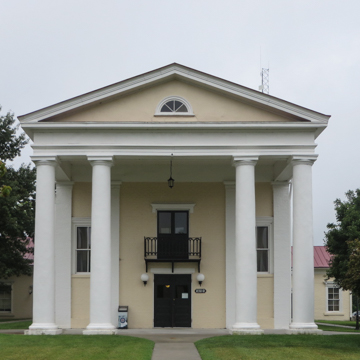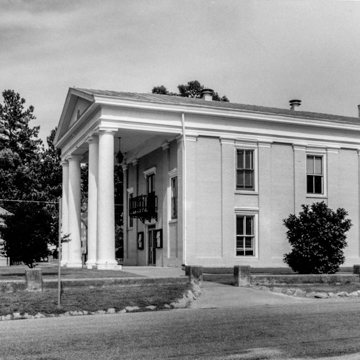When completed in 1851, the courthouse's exterior was admired, but its interior arrangements were deemed unsatisfactory. By 1858 remodeling had begun but was interrupted by the Civil War and was unfinished in 1865 when General Philip Sheridan and his Union troops occupied the square. As illustrated in Frank Leslie's Illustrated Newspaper (July 1865), the courthouse had long poles propping up its eaves, was surrounded by a wooden fence to keep out wandering stock, and a communal, latticed well with a pyramidal roof stood in the foreground. On the right stood a small building, probably the clerk's office, which was later incorporated as a courthouse wing. The courthouse itself was a gable-end building with the front and side bays delineated by two-story pilasters. On the front, two matching flights of stairs met at a central balconied landing that in turn led into the courtroom on the newly created upper floor. Like a number of other converted courtrooms—including that at nearby Lunenburg County (LU1) before it was remodeled—the Dinwiddie courtroom was probably two stories high with a rear balcony. Renovations in the early twentieth century led to the removal of almost all of the original interior trim. In the 1930s the courthouse gained a rear addition, a wing on the left designed to balance the older office on the right, and the monumental Doric portico. The court moved to a new building (DW1) in 1998.
You are here
Historic Dinwiddie County Courthouse
If SAH Archipedia has been useful to you, please consider supporting it.
SAH Archipedia tells the story of the United States through its buildings, landscapes, and cities. This freely available resource empowers the public with authoritative knowledge that deepens their understanding and appreciation of the built environment. But the Society of Architectural Historians, which created SAH Archipedia with University of Virginia Press, needs your support to maintain the high-caliber research, writing, photography, cartography, editing, design, and programming that make SAH Archipedia a trusted online resource available to all who value the history of place, heritage tourism, and learning.






